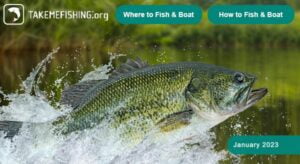
Have you been wondering how to catch bass in the winter? Maybe you’ve tried some of your “go-to” largemouth baits and lures to no avail or you want to try bass fishing in the winter for the first time. Whatever your reasons might be, just know that establishing cold weather patterns and catching bass in winter is entirely possible if you remember a few key tips.
USEFUL TIPS FOR BASS FISHING IN THE WINTER
Bass fishing in winter does take a certain amount of patience and determination, but there are ways you can boost your chances of success. Besides, when the bite is on and you can do no wrong with the baits or lures you select, you’re not learning as much. Use these tips, along with the challenges that winter brings, to become a better angler.
1. DOWNSIZE YOUR PROFILES
Perhaps the most important tip that applies to bass fishing winter weather conditions is to downsize your bait sizes. Instead of a 4 or 5-inch soft plastic worm or creature bait, downsize to 1.5 or 2 inches. Since the cold weather causes the metabolism of largemouth bass to slow down, they are all about finding an easy meal. Bass may be suspended during this time of year and prefer to “snack” on smaller, more convenient prey items that are presented right in front of them.
2. LIGHTEN UP ON YOUR LINE
Lighten up your line when winter largemouth bass fishing in cold, clear water conditions. The reason for this is two-fold. First, lighter line and more sensitive fishing rod will help you detect lighter bites that are associated with cooler water. Second, clear water conditions that are often associated with winter can mean wary largemouth bass that will only bite when you scale down your line to 10-pound, or even 8-pound fluorocarbon. You will have to be more careful when fishing around cover or structure, but better to get the bites and lose a fish or two than not get the bites at all.
3. SLOW DOWN YOUR RETRIEVE
Another important tip is to slow down your retrieve when water temperatures drop. When you’re fishing for bass in winter (when their metabolism slows), they will be less likely to expend the energy that’s required to chase down a fast-moving bait or lure. Use soft plastic baits or lures (such as Texas-rigged or Carolina-rigged worms) that move slowly along the bottom instead.
4. CONSIDER WATER TEMPERATURE
Focus your fishing efforts on water that is likely to be warmer, even if it’s just by a few degrees. This can mean looking for bottom that consists of dark clay, gravel, rocks, or concrete boat ramps where the water temperature is likely to be higher. This is an important tip when it comes to winter bass fishing because darker bottom, rocks, and concrete will all retain heat from the sun. In addition, areas where water might be flowing into a lake or pond from a warmer spring-fed river or creek are also good spots to try.
Do you feel more confident now about figuring out how to catch bass in the winter? Hopefully you do. The best way to find the fish and establish winter patterns is to get out there and apply these tips.
Original article from Take Me Fishing
By DEBBIE HANSON 12/7/2022

